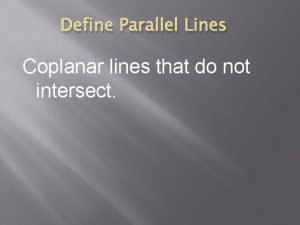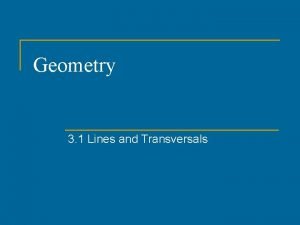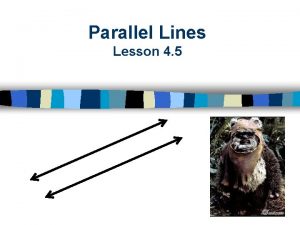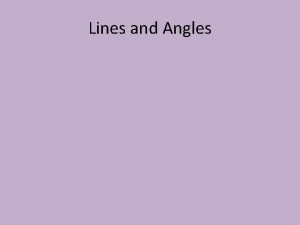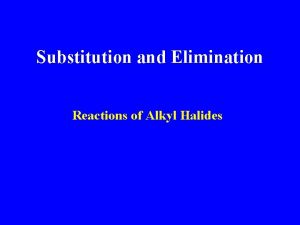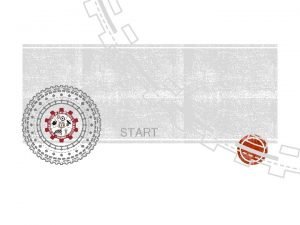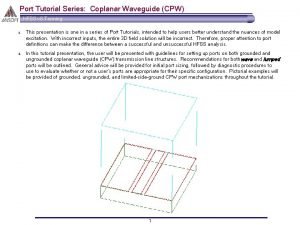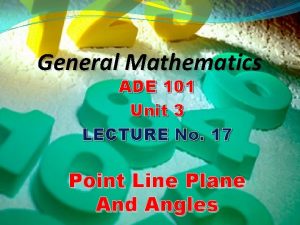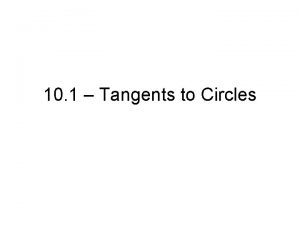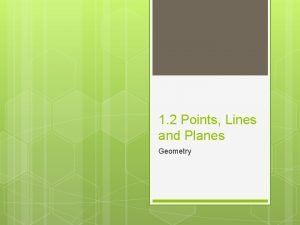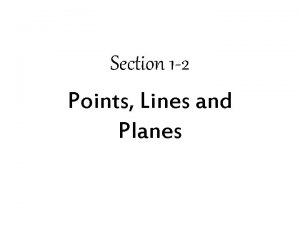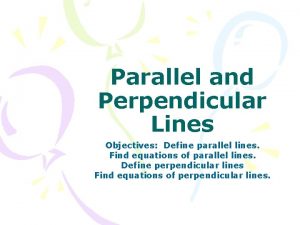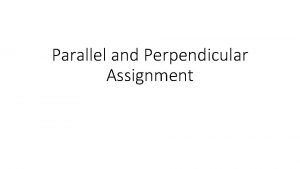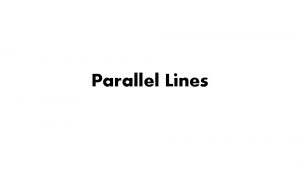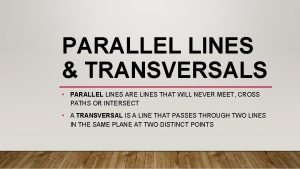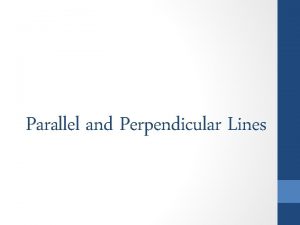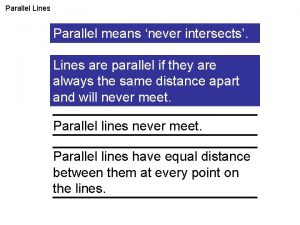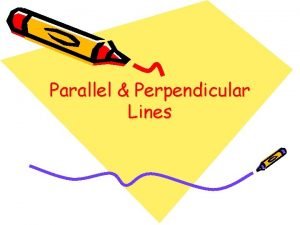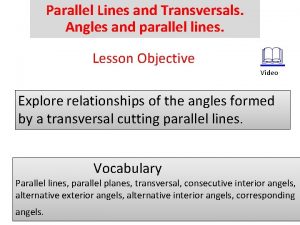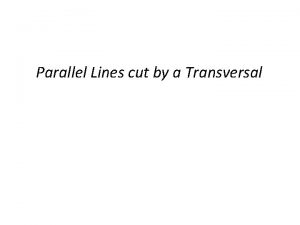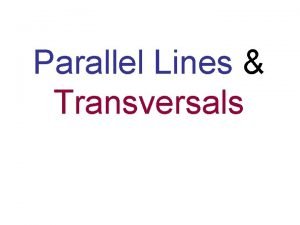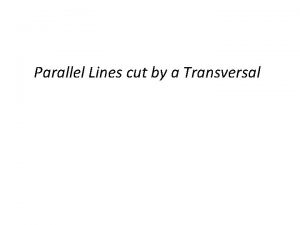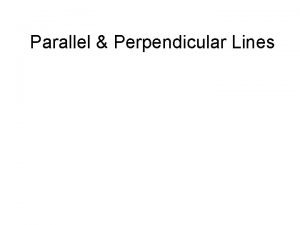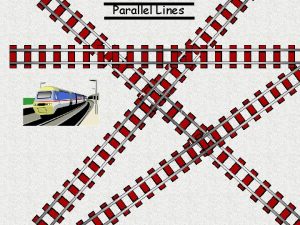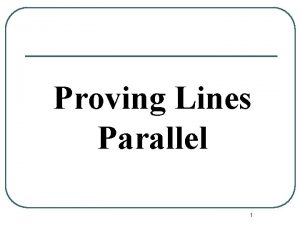Define Parallel Lines Coplanar lines that do not




























- Slides: 28

Define Parallel Lines Coplanar lines that do not intersect.

Define Skew Lines that do not intersect and are not coplanar.

What angles are marked? Corresponding Angles

What angles are marked? Alternate Interior Angles

What angles are marked? Consecutive Interior Angles

What angles are marked? Alternate Exterior Angles

What is the Parallel Postulate? If there is a line and a point not on the line, then there is exactly one line through the point parallel to the given line.

What is the Perpendicular Postulate? If there is a line and a point not on the line, then there is exactly one line through the point perpendicular to the given line.

Corresponding Angles Postulate If two parallel lines are cut by a transversal, then the pairs of corresponding angles are congruent.

Alternate Interior Angles Theorem If two parallel lines are cut by a transversal, then the pairs of alternate interior angles are congruent.

Alternate Exterior Angles Theorem If two parallel lines are cut by a transversal, then the pairs of alternate exterior angles are congruent.

Consecutive Interior Angles Theorem If two parallel lines are cut by a transversal, then the pairs of consecutive interior angles are supplementary.

Corresponding Angles Converse If two lines are cut by a transversal so that the corresponding angles are congruent, then the lines are parallel.

Alternate Interior Angles Converse If two lines are cut by a transversal so the alternate interior angles are congruent, then the lines are parallel.

Alternate Exterior Angles Converse If two lines are cut by a transversal so the alternate exterior angles are congruent, then the lines are parallel.

Consecutive Interior Angles Converse If two lines are cut by a transversal so the consecutive interior angles are supplementary, then the lines are parallel.

Transitive Property of Parallel Lines If two lines are parallel to the same line, then they are parallel to each other.

What is the slope equation?

Slopes of parallel lines In a coordinate plane, two nonvertical lines are parallel if and only if they have the same slope.

Slopes of perpendicular lines In a coordinate plane, two nonvertical lines are perpendicular if and only if, the product of their slopes is – 1.

Slope-intercept form y = mx + b

Standard Form Ax + By = C A, B, and C are integers A>0

Different slopes Line that is rising from left to right Slope is positive Horizontal line Slope is zero Vertical Line Slope is undefined Line that is falling from left to right Slope is negative

If two lines intersect to form a linear pair of congruent angles, then the lines are perpendicular.

If two lines are perpendicular, then they intersect to form four right angles.

If two sides of two adjacent acute angles are perpendicular, then the angles are complementary.

Perpendicular Transversal Theorem If a transversal is perpendicular to one of two parallel lines, then it is perpendicular to the other.

Lines Perpendicular to a Transversal Theorem In a plane, if two lines are perpendicular to the same line, then they are parallel to each other.
 Are parallel lines coplanar
Are parallel lines coplanar 3-1 parallel lines and transversals geometry answers
3-1 parallel lines and transversals geometry answers Lines are lines that never touch and are coplanar.
Lines are lines that never touch and are coplanar. Parallel lines def
Parallel lines def Example of parallel forces
Example of parallel forces Site:slidetodoc.com
Site:slidetodoc.com Parallel words
Parallel words Phân độ lown
Phân độ lown Block nhĩ thất cấp 1
Block nhĩ thất cấp 1 Thể thơ truyền thống
Thể thơ truyền thống Thơ thất ngôn tứ tuyệt đường luật
Thơ thất ngôn tứ tuyệt đường luật Walmart thất bại ở nhật
Walmart thất bại ở nhật Tìm vết của đường thẳng
Tìm vết của đường thẳng Con hãy đưa tay khi thấy người vấp ngã
Con hãy đưa tay khi thấy người vấp ngã Tôn thất thuyết là ai
Tôn thất thuyết là ai Gây tê cơ vuông thắt lưng
Gây tê cơ vuông thắt lưng Sau thất bại ở hồ điển triệt
Sau thất bại ở hồ điển triệt Relationships of lines
Relationships of lines The inner terminus of a fingerprint
The inner terminus of a fingerprint Sadlier unit 1 level d synonyms
Sadlier unit 1 level d synonyms Coplanar formula
Coplanar formula Anti-coplanar
Anti-coplanar Is called
Is called Wave port hfss
Wave port hfss Non coplanar points
Non coplanar points Line that is tangent to two coplanar circles
Line that is tangent to two coplanar circles Three points are coplanar
Three points are coplanar Properties of tangent to a circle
Properties of tangent to a circle Fcdba
Fcdba
